![]()
![]()
![]()
Use LEFT and RIGHT arrow keys to navigate between flashcards;
Use UP and DOWN arrow keys to flip the card;
H to show hint;
A reads text to speech;
113 Cards in this Set
- Front
- Back
|
What are two things that Duplex Examination allows?
|
1. Specific anatomical localization of arterial lesion
2. Precise placement of Doppler sample volume within the vessel |
|
|
What is the range of transducers used in Duplex scanning?
|
3.5-7.5MHz
|
|
|
What is the first examination technique after choosing the proper transducer?
|
Identify arterial segment in long axis
|
|
|
When looking for sample volume through a vessel what are three things that must be maintained?
|
1. 60 degrees or less
2. Move wall to wall down the segment 3. Look for focal flow disturbance or velocity increase |
|
|
What are the two standard sites that are examined for the CFA?
|
1. Proximal
2. Distal |
|
|
What site must be found for the PFA
|
Origin
|
|
|
What 4 segments of the SFA must be viewed?
|
1. Origin
2. Proximal 3. Mid 4. Distal |
|
|
What are the two standard sites of the Popliteal A?
|
1. Proximal
2. Distal |
|
|
What are the two standard sites of the ATA?
|
1. Proximal
2. Distal |
|
|
What two standard sites are examined for the PTA?
|
1. Proximal
2. Distal |
|
|
What two standard sites are examined for the Peroneal A?
|
1. Proximal
2. Distal |
|
|
What are 4 Spectral Manifestations of arterial obstruction?
|
1. Local effects within the stenosis
2. Spectral measurements 3. Post stenotic flow disturbance 4. Effects proximal to the lesion |
|
|
What are 2 local effects of spectral manifestation?
|
1. Velocity increase
2. Audible Doppler signal has a high pitched smooth sound that is proportional to the increase in velocity |
|
|
What are the 4 spectral measurements?
|
1. Peak Systolic
2. Pulsatility 3. Peak End Diastolic 4. Waveform analysis |
|
|
Distal to the stenosis what type of flow will be observed? What type of flow should be observed if the stenosis didn't exist?
|
Disturbed and Laminar
|
|
|
True or False
Will the severity of flow disturbance increase as the severity of the stenosis does with post stenotic flow? |
True
|
|
|
What are two proximal effects of a stensosis?
|
1. Spectral waveform may change due to outflow obstruction
2. Triphasic waveform may persist even following exercise |
|
|
What are the 3 distal effects of a stenosis?
|
1. Spectral waveform may change due to inflow obstruction
2. Systolic acceleration is slowed, waveform is dampened at times 3. May have a return of triphasic flow due to collaterals |
|
|
In a stenosis why might proximal or distal manifestations not occur?
|
There is excellent collateral flow
|
|
|
What are two ways that collateral channels can be altered?
|
1. Increase in velocity and volume flow
2. Reversed flow direction |
|
|
What are the 5 types of normal criteria for duplex?
|
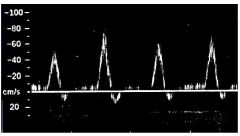
1. Triphasic waveform
2. Peak Systolic Volume of 100 cm/sec 3. No spectral broadening 4. Normal proximal and distal 5. No visible plaque |
|
|
What is the Duplex Criteria for 1-19%?
|
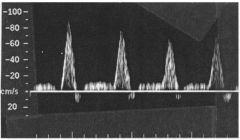
1. Triphasic
2. Peak Systolic Volume of 100 cm/sec 3. Minimal spectral broadening 4. Normal proximal and distal 5. May see visible plaque |
|
|
What is the Duplex Criteria for 20-49%?
|
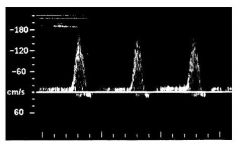
1. Triphasic or Biphasic
2. Peak Systolic Volume increased 3. Spectral broadening 4. Normal proximal and distal 5. May see visible plaque |
|
|
What is the Duplex Criteria for 50-99%?
|
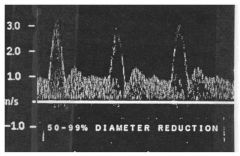
1. No reverse flow component
2. Peak Systolic Volume increase > 100% 3. Marked spectral broadening 4. Post stenotic turbulence 5. Dampening proximal and distal |
|
|
What is the Duplex Criteria for and occluded vessel?
|
1. No detectable flow
2. Preocclusive thump 3. Marked dampening proximal and distal to lesion 4. Monophasic flow in distal vessels 5. Collaterals present (not conclusive) |
|
|
What are 5 types of criteria for tandem lesions?
|
1. Can cause intermittent claudication
2. Diffuse moderate narrowing 3. Lesions several cm long 4. Multiple < 50% lesions 5. Additive due to combined pressure drop |
|
|
True or False
Energy cannot be changed, but it can be destroyed |
False
Energy can be changed, but cannot be destroyed |
|
|
Define Bernoulli's Principle
|
Total energy of fluid in a steadily flowing path is a constant
|
|
|
What is known as the Bernoulli effect?
|
Reduction in pressure that accompanies the increase of velocity of fluid flow
|
|
|
Does blood flow through an open or closed system?
|
Closed
|
|
|
How does blood flow in an energy gradient?
|
High to low
|
|
|
True or False
Blood flow occurs because an energy gradient |
True
|
|
|
Blood will flow through what type of resistance pathway?
|
Path of least resistance
|
|
|
True or False
Blood flows from areas of low pressure to areas of high pressure |
False
Blood flows from high to low pressure |
|
|
What is the average blood pressure in the aorta?
|
100mmHg
|
|
|
How much pressure will be lost between the aorta and the arterioles?
|
45mmHg
|
|
|
What is the average pressure in the capillary beds?
|
10mmHG
|
|
|
True or False
Capillaries have a higher pressure than venules |
True
|
|
|
True or False
Blood flows from the venules to the capillary bed |
False
Blood flows from the capillary beds to the venules |
|
|
What are the 4 things that determine arterial blood pressure?
|
1. Cardiac output
2. Resistance exerted against flow 3. P = Q x R 4. As flow or resistance increases so does pressure |
|
|
True or False
Increasing flow increases cardiac output |
True
|
|
|
True or False
Decreasing the radius of a vessel will cause a decrease in blood flow |
False
Decreasing radius will increase blood flow |
|
|
True or False
Arterioles act as control valves |
True
|
|
|
Define Cardiac Output and what the 3 things affect it
|
Definition: Amount of blood pumped out of the heart each minute
Affected by: 1. Heart Rate 2. Strength of each heart contraction 3. Amount of blood pumped out with each contraction |
|
|
True or False
Resistance in vessels cannot affect pressure |
False
Resistance can affect pressure |
|
|
True or False
Resistance can change and adapt to demands of the body |
True
|
|
|
What are the four ways the arterial vessels react with elasticity and distensibility when the ventricles contract?
|
1. Blood is forced into the arterial system
2. Arterial system is already filled with blood 3. Arteries stretch or distend to accommodate extra volume of blood 4. After contraction elasticity of vessel allows them to snap back-blood forced into the capilliary |
|
|
What are the four ways the arterial vessels react with elasticity and distensibility when the ventricles relax?
|
1. Elasticity of arterial wall bounces back
2. Blood propelled farther down vessel 3. Blood flows more steadily, slower and smoother, less pulsatile 4. Allows for exchange of nutrients and wastes |
|
|
What is the average blood pressure once the blood leaves the ventricles?
|
100mmHg
|
|
|
True or False
Capillaries can handle the amount of pressure that is initially pushed out of the ventricles? |
False
The capillaries can not handle that amount of pressure |
|
|
What is the average velocity of blood leaving the ventricles?
|
80-100 cm/sec
|
|
|
True of False
Rate of velocity depends on the amount of nutrients exchanged within the capillaries |
True
|
|
|
What is viscosity?
|
Thickness of blood
|
|
|
True or False
Greater the viscosity the faster blood moves |
False
Greater the viscosity the slower blood moves |
|
|
Viscosity contributes to what type of gradient?
|
Energy
|
|
|
True or False
Viscosity produces resistance to flow |
True
|
|
|
Define Friction
|
An energy gradient necessary to move blood from point A to point B
|
|
|
What creates friction in blood vessels?
|
Resistance of blood moving against itself and arterial walls
|
|
|
True or False
Friction causes energy loss in the form of heat |
True
|
|
|
True or False
When friction occurs all of the pressure in converted into heat |
False
Only some of the pressure in converted into heat |
|
|
True or False
As blood moves through arteries pressure is increased against the walls |
False
As blood moves the pressure is continually lost against the walls |
|
|
True or False
The more friction there is exerted the more pressure and heat loss |
True
|
|
|
True or False
The narrower and shorter the length of the vessel the greater loss in friction |
False
The narrower and longer the vessel the greater the friction |
|
|
Define Inertia
|
An object at rest stays as rest and an object in motion stays in motion
|
|
|
True or False
Can an outside force change Inertia |
True
|
|
|
True or False
Without the force of contraction of the heart; blood flow will eventually stop |
True
|
|
|
True of False
Inertial losses extend the energy gradient |
False
Inertial losses diminish energy gradient |
|
|
What causes the most inertial energy loss within the cardiovascular system?
|
Acceleration and Deceleration
|
|
|
True or False
Less energy is lost as blood flows through branches and around bends |
False
More energy is lost |
|
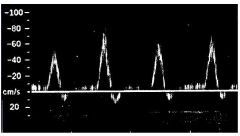
Name this type of Duplex
|
Normal Duplex
|
|
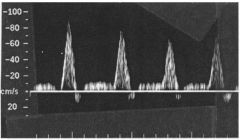
Name this type of Duplex
|
1-19% Duplex
|
|
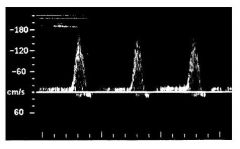
Name this type of Duplex
|
20-49% Duplex
|
|
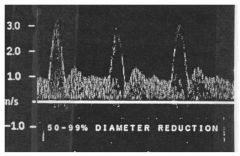
Name this type of Duplex
|
50-99% Duplex
|
|
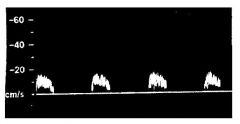
Is this pre or post occlusive?
|
Pre- Occlusive
|
|
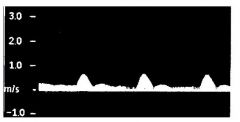
Is this pre or post stenotic?
|
Pre-Stenotic
|
|
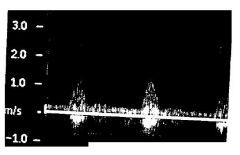
Is this pre or post stenotic?
|
Post-Stenotic
|
|
|
Define Poiseuille's Law
|
Summary of relationship among factors producing pressure gradient across an arterial segment
|
|
|
What is Poiseuille's Equaiton?
|
P = Q8Ln/pr^4
|
|
|
True or False
Any change in diameter, length of vessel or viscosity affects pressure gradient or energy loss |
True
|
|
|
What will produce the biggest pressure change within Poiseuille's Equation?
|
Radius reduction
|
|
|
True or False
75% reduction in diameter increases energy loss by a factor of 32 |
False
50% reduction in diameter increases energy loss by a factor of 16 |
|
|
True or False
Velocity and Flow are interchangeable |
False
Velocity and Flow are NOT interchangeable |
|
|
True or False
Flow equals the amount of blood (volume) over time |
True
|
|
|
What is flow expressed in units?
|
mL/min
|
|
|
True or False
Velocity equals distance over time |
True
|
|
|
What is velocity?
|
Speed of the blood
|
|
|
How is velocity measured in units?
|
cm/sec, m/sec
|
|
|
True or False
The less resistance blood meets, the greater the flow |
True
|
|
|
True or False
Velocity of flow is inversely proportional to the radius of the vessel |
True
|
|
|
Define Pulsatile flow
|
Is the impact of the blood striking an artery as it surges out of the ventricle and transmitted along the length of the vessel
|
|
|
Where can pulatile flow be felt?
|
Where the vessel is close to the surface of the body
|
|
|
When pulsatile flow is felt what is it called?
|
Pulse
|
|
|
When does pulsatile flow occur?
|
During Systole
|
|
|
When will pulsatile flow become steady flow?
|
Farther from the heart
|
|
|
Where can you find steady flow?
|
Capillary beds
|
|
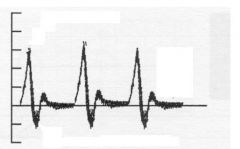
What are two main components of a Triphasic waveform?
|
1. One Systolic component
2. One or more Diastolic components |
|
|
What 2 characteristics should be found in the systolic component of a triphasic waveform?
|
1. Large positive deflection
2. High net forward flow velocity |
|
|
What 3 characteristics should be found in the diastolic component of a triphasic waveform?
|
1. First, brief period of new flow reversal
2. Immediately followed by another positive deflection 3. Called diastolic forward flow component |
|
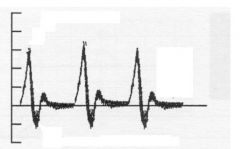
Name this type of waveform
|
Triphasic
|
|
|
Define Biphasic
|
1. May be abnormal
2. Must observe for deterioration of waveform (Triphasic to Biphasic, Triphasic to Monophasic) 3. Must observe from one level to next |
|
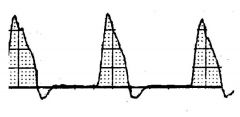
Name this waveform.
Abnormal or Normal |
Biphasic Normal
|
|
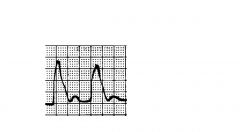
Name this waveform.
Abnormal or Normal |
Biphasic Normal
|
|
|
Define Monophasic
|
1. Usually dampened waveform
2. May be proximal or distal to stenosis |
|
|
What 4 signs of a monophasic waveform will be found proximal to a stenosis?
|
1. Signal is of short duration-slapping sound
2. Low amplitude 3. No reversal component 4. May be normal upstroke |
|
|
What 3 signs of a monophasic waveform will be found distal to a stenosis?
|
1. Low amplitude
2. Slow upstroke 3. Loss of reversal component |
|
|
Why might a monophasic waveform become more normal distal to a stenosis?
|
If additional obstructions are absent
|
|
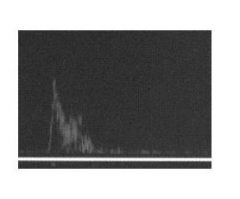
Name this type of waveform
Normal or abnormal? Pre or Post Stenosis? |
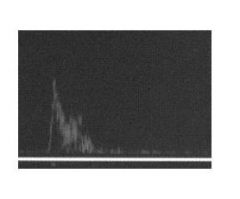
Abnormal Monophasic Pre-Stenosis
|
|

Name this type of waveform
Normal or abnormal? Pre or Post Stenotic? |

Abnormal Monophasic Post- Stenosis
|
|
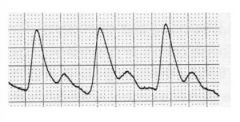
Is this a Normal or Abnormal post exercise waveform
|

Normal
|
|
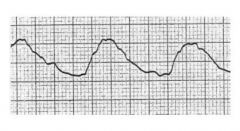
Is this a Normal or Abnormal post exercise waveform
|
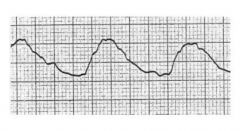
Abnormal
|
|
|
True or False
Tri-phasic is the optimum signal for normalcy |
True
|
|
|
True or False
Bi-phasic may indicate a gain of reversal component which is directly related to the proximal peripheral resistance. Could be normal if in exercised state |
False
Bi-phasic may indicate a loss of reversal component which is directly related to the distal peripheral resistance. |
|
|
True or False
Monophasic is sometimes normal |
False
Monophasic is never normal |

